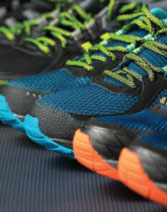“I didn’t need pain medication,” Raymond says. “I was back to my normal schedule in a couple of days, and the incisions healed quickly. I didn’t know it was going to be so easy.”

An 18-Year-Old’s Painful Hernia Is Repaired With Robotic-Assisted Surgery, Allowing Faster Recovery.
If robotic surgery makes you imagine a scene from science fiction, where a machine operates on you with a complete lack of caring, think again. The truth is that robotic surgery is performed by a very human, highly skilled surgeon who is assisted by advanced technology that provides enhanced control, dexterity and precision.
Sergey Grachev, MD, is one such surgeon, having undergone rigorous training to achieve his expertise and certification. Robotic surgery can be used for a variety of procedures in many fields, including cancer, colon and gallbladder surgery, as well as hernia repair.
A hernia occurs when an internal organ pushes through the surrounding layer of muscle and tissue and causes a bulge. There are a variety of types, but the most common, an inguinal hernia, occurs within the abdominal cavity, between the chest and the hips.
This was the type that Raymond Lubeski, 18, a college student from Manahawkin, noticed when he woke up one morning.
A Trusted Provider
Raymond went to see Dr. Grachev, who already had a trusted relationship with the Lubeski family: Two of Raymond’s uncles had undergone successful open hernia surgery with him in the past.
“I was scared when I first noticed it, but I recognized what it was. My uncles had experienced the same thing,” Raymond says. “I don’t know what it came from, since I hadn’t lifted anything heavy. By the time I went to see Dr. Grachev, it had begun to hurt. He told me I should take care of it quickly and set up an appointment to have it repaired with robotic laparoscopy at Community Medical Center.”
“It’s important to take care of a hernia at an early stage, when it’s still small,” says Dr. Grachev. “It’s better to take care of it before it becomes painful and complications develop.” Inguinal hernias don’t improve on their own, and, over time, the contents of the hernia can become incarcerated, or trapped, in the abdominal wall. If blood supply to the trapped tissue becomes cut off (called a strangulated hernia), a life- threatening situation can develop.
Robotic surgery has transformed hernia repair from a painful abdominal procedure that results in hospitalization, wound drains and a sizable abdominal scar into an outpatient procedure accomplished with small incisions. This leads to less chance of infection, less pain and a quicker return to normal daily life.
Two Different Approaches
In traditional open inguinal hernia repair, the surgeon makes an incision in the groin and pushes the protruding tissue back into the abdomen. The weakened area is then sewn, often reinforced with synthetic mesh. Stitches, staples or glue are used to close the opening. Robotic laparoscopic repair is performed through several small abdominal incisions made by the surgeon. A small tube equipped with a tiny camera is inserted into one of these incisions. Guided by the camera, the surgeon repairs the hernia by inserting tiny instruments through the other incisions.
“Robotic surgery provides much better visualization because of the optical technology,” says Dr. Grachev. “And the instrumentation is more precise, which allows better suturing than the open method.”
At the hospital, Raymond received general anesthesia for his surgery, which lasted less than two hours. “The doctor and the staff at Community Medical Center were very reassuring in telling me that everything was going to be okay,” Raymond memembers.
No Pain Meds Needed
Following surgery, Raymond was able to go home later that same day.
“I didn’t need pain medication,” Raymond says. “I was back to my normal schedule in a couple of days, and the incisions healed quickly. I didn’t know it was going to be so easy.”
Community Medical Center has been accredited as a Center of Excellence for Robotic Surgery, one of only three such centers in New Jersey, and was an early adopter of robotic surgery—its program was the first of its kind in the region.
But for an 18-year-old like Raymond Lubeski, it’s not the technological advancements that are so impressive; it’s the fact that robotic surgery rid him of his hernia and enabled him to swiftly recover and return to his busy life.